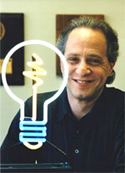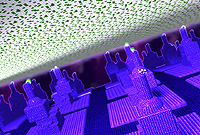
Ray Kurzweil is a 21st Century Renaissance man; inventor, entrepreneur, writer, futurist and much more.
His write-up at Wikipedia gives you a brief glimpse into an extraordinary mind:
"Kurzweil was the principal developer of the first omni-font optical character recognition system, the first print-to-speech reading machine for the blind, the first CCD flatbed scanner, the first text-to-speech synthesizer, the first electronic musical instrument capable of recreating the sound of a grand piano and other orchestral instruments (which he developed at the urging of Stevie Wonder, who was amazed by his OCR reading machine), and the first commercially marketed large-vocabulary speech recognition system. He has founded nine businesses in the fields of OCR, music synthesis, speech recognition, reading technology, virtual reality, financial investment, medical simulation, and cybernetic art."
Bill Gates dubbed him "the best at predicting the future of artificial intelligence."
He has been described by the Wall Street Journal as "the restless genius."
In 2001 he wrote an essay, "The Law of Accelerating Returns," where he laid out one of his most well known theories, concerning the exponential growth pattern of technologies.
It states, in short:
"An analysis of the history of technology shows that technological change is exponential, contrary to the common-sense 'intuitive linear' view. So we won't experience 100 years of progress in the twenty first century—it will be more like 20,000 years of progress (at today's rate). The 'returns,' such as chip speed and cost-effectiveness, also increase exponentially. There's even exponential growth in the rate of exponential growth. Within a few decades, machine intelligence will surpass human intelligence, leading to The Singularity—technological change so rapid and profound it represents a rupture in the fabric of human history. The implications include the merger of biological and nonbiological intelligence, immortal software-based humans, and ultra-high levels of intelligence that expand outward in the universe at the speed of light."
Recently I had a chance to catch up with him, and posed the following question: "If you had the attention of the entire world, what would you say regarding molecular manufacturing?"
Here is his response: "When we have full molecular manufacturing, we will be able to create any physical products we need from information files just as we can create music, movies, and books from pure information today. In about twenty years, the original goals of communism ("from each according to their ability, to each according to their needs") will be achieved not through forced collectivism but through the information technologies of nanotechnology and artificial intelligence."
Learn more about Ray Kurzweil at http://en.wikipedia.org/wiki/Ray_Kurzweil




 Ray Kurzweil is a 21st Century Renaissance man; inventor, entrepreneur, writer, futurist and much more.
Ray Kurzweil is a 21st Century Renaissance man; inventor, entrepreneur, writer, futurist and much more.





